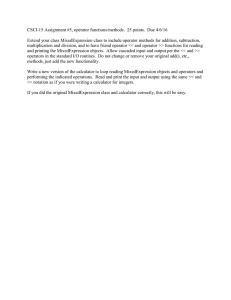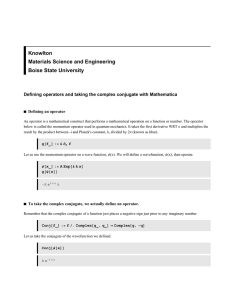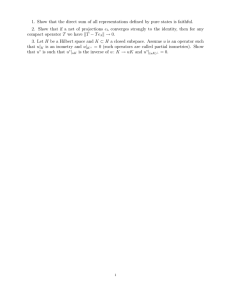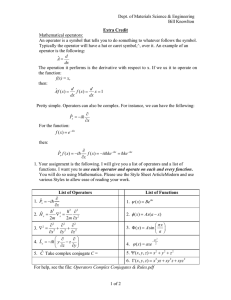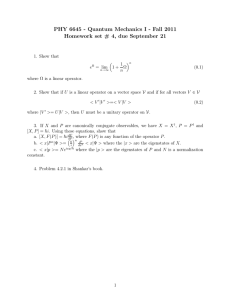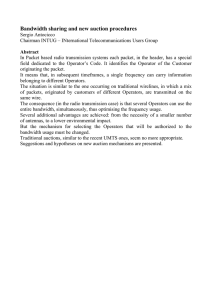The method of the weakly conjugate operator:
advertisement
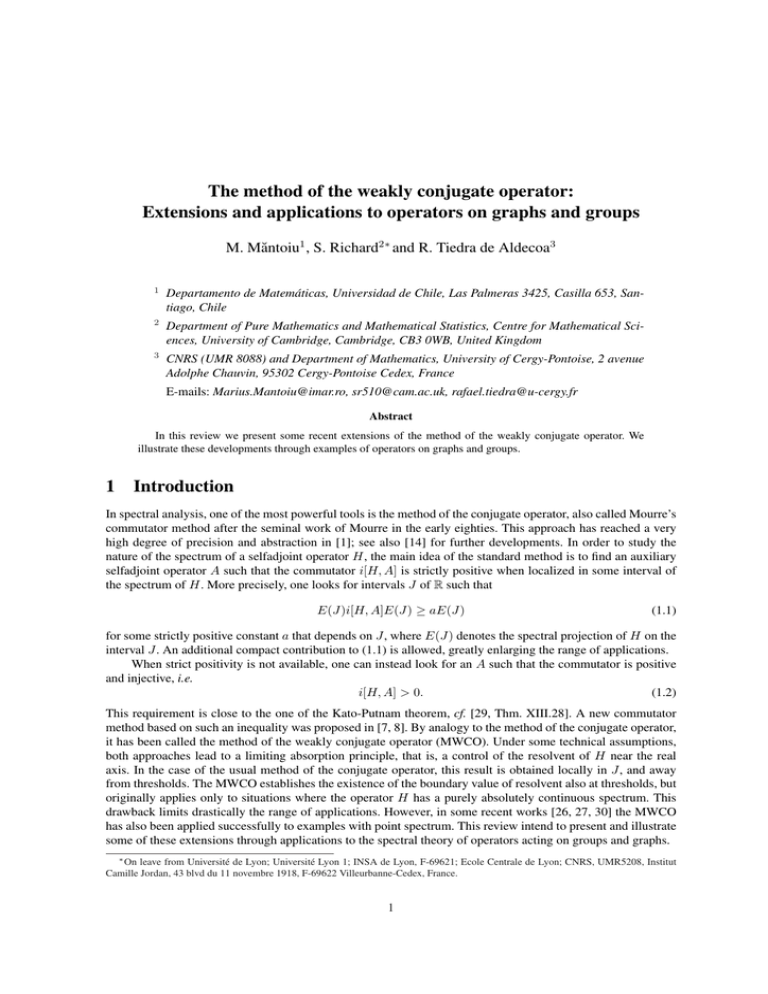
The method of the weakly conjugate operator:
Extensions and applications to operators on graphs and groups
M. Măntoiu1 , S. Richard2∗ and R. Tiedra de Aldecoa3
1
Departamento de Matemáticas, Universidad de Chile, Las Palmeras 3425, Casilla 653, Santiago, Chile
2
Department of Pure Mathematics and Mathematical Statistics, Centre for Mathematical Sciences, University of Cambridge, Cambridge, CB3 0WB, United Kingdom
3
CNRS (UMR 8088) and Department of Mathematics, University of Cergy-Pontoise, 2 avenue
Adolphe Chauvin, 95302 Cergy-Pontoise Cedex, France
E-mails: Marius.Mantoiu@imar.ro, sr510@cam.ac.uk, rafael.tiedra@u-cergy.fr
Abstract
In this review we present some recent extensions of the method of the weakly conjugate operator. We
illustrate these developments through examples of operators on graphs and groups.
1 Introduction
In spectral analysis, one of the most powerful tools is the method of the conjugate operator, also called Mourre’s
commutator method after the seminal work of Mourre in the early eighties. This approach has reached a very
high degree of precision and abstraction in [1]; see also [14] for further developments. In order to study the
nature of the spectrum of a selfadjoint operator H, the main idea of the standard method is to find an auxiliary
selfadjoint operator A such that the commutator i[H, A] is strictly positive when localized in some interval of
the spectrum of H. More precisely, one looks for intervals J of R such that
E(J)i[H, A]E(J) ≥ aE(J)
(1.1)
for some strictly positive constant a that depends on J, where E(J) denotes the spectral projection of H on the
interval J. An additional compact contribution to (1.1) is allowed, greatly enlarging the range of applications.
When strict positivity is not available, one can instead look for an A such that the commutator is positive
and injective, i.e.
i[H, A] > 0.
(1.2)
This requirement is close to the one of the Kato-Putnam theorem, cf. [29, Thm. XIII.28]. A new commutator
method based on such an inequality was proposed in [7, 8]. By analogy to the method of the conjugate operator,
it has been called the method of the weakly conjugate operator (MWCO). Under some technical assumptions,
both approaches lead to a limiting absorption principle, that is, a control of the resolvent of H near the real
axis. In the case of the usual method of the conjugate operator, this result is obtained locally in J, and away
from thresholds. The MWCO establishes the existence of the boundary value of resolvent also at thresholds, but
originally applies only to situations where the operator H has a purely absolutely continuous spectrum. This
drawback limits drastically the range of applications. However, in some recent works [26, 27, 30] the MWCO
has also been applied successfully to examples with point spectrum. This review intend to present and illustrate
some of these extensions through applications to the spectral theory of operators acting on groups and graphs.
∗ On leave from Université de Lyon; Université Lyon 1; INSA de Lyon, F-69621; Ecole Centrale de Lyon; CNRS, UMR5208, Institut
Camille Jordan, 43 blvd du 11 novembre 1918, F-69622 Villeurbanne-Cedex, France.
1
Compared to the huge number of applications based on an inequality of the form (1.1), the number of
papers that contain applications of the MWCO is very small. Let us cite for example the works [13, 24, 25]
that deal with the original form of the theory, and the papers [12, 20] that contain very close arguments. The
derivation of the limiting absorption principle of [12] has been abstracted in [30]. The framework of [30] is still
the one of the MWCO, but since its result applies a certain class of two-body Schrödinger operators which have
bound states below zero, it can also be considered as the first extension of the MWCO dealing with operators
that are not purely absolutely continuous. The main idea of [30] is that H itself can add some positivity to (1.2).
The new requirement is the existence of a constant c ≥ 0 such that
−cH + i[H, A] > 0.
This inequality, together with some technical assumptions, lead to a limiting absorption principle which is either
uniform on R if c = 0 or uniform on [0, ∞) if c > 0.
The extensions of the MWCO developed in [26, 27] are of a different nature. In these papers, the operators
H under consideration admit a natural conjugate operator A that fulfills the inequality i[H, A] ≥ 0, namely,
the commutator is positive but injectivity may fail. In that situation, the authors considered a decomposition
H := K ⊕ G, and the restrictions of H and i[H, A] to these subspaces. In favorable circumstances the injectivity
can be restored in one of the subspace, and a comprehensible description of the vectors of the second subspace
can be given. This decomposition leads again to statements that are close to the ones of the MWCO, but which
apply to operators with arbitrary spectrum. This extension is described in Section 2.2.
We would also like to mention the references [2, 3]. They pereform what can be considered as a unitary
version of the MWCO and extend the Kato-Putnam analysis of unitary operators to the case of unbounded
conjugate operators. The main applications concern time-depending propagators.
The content of this review paper is the following. In Section 2 we recall the original method of the weakly
conjugate operator, and then present an abstract version of the approach used in [26, 27]. In Section 3 we present
applications of this approach to the study of adjacency operators on graphs. A similar analysis for operators of
convolution on locally compact groups is performed in Section 4.
Let us finally fix some notations. Given a selfadjoint operator H in a Hilbert space H, we write Hc (H),
Hac (H), Hsc (H), Hs (H) and Hp (H) respectively for the continuous, absolutely continuous, singularly continuous, singular and pure point subspaces of H with respect to H. The corresponding parts of the spectrum of
H are denoted by σc (H), σac (H), σsc (H), σs (H) and σp (H).
Acknowledgements. M. M. was partially supported by the Chilean Science Foundation Fondecyt under
the Grant 1085162. S. R. and R. T. d A. thank the Swiss National Science Foundation for financial support.
2 The method of the weakly conjugate operator
In this section we recall the basic characteristics of the method of the weakly conjugate operator, as originally
introduced and applied to partial differential operators in [7, 8]. We then present the abstract form of the extension developed in [26, 27]. The method works for unbounded operators, but for our purposes it is enough to
assume H bounded.
2.1 The standard theory
We start by introducing some notations. The symbol H stands for a Hilbert space with scalar product h·, ·i
and norm k · k. Given two Hilbert spaces H1 and H2 , we denote by B(H1 , H2 ) the set of bounded operators
from H1 to H2 , and put B(H) := B(H, H). We assume that H is endowed with a strongly continuous unitary
group {Wt }t∈R . Its selfadjoint generator is denoted by A and has domain D(A). In most of the applications A
is unbounded.
Definition 2.1. A bounded selfadjoint operator H in H belongs to C 1 (A; H) if one of the following equivalent
condition is satisfied:
2
(i) the map R 3 t 7→ W−t HWt ∈ B(H) is strongly differentiable,
(ii) the sesquilinear form
D(A) × D(A) 3 (f, g) 7→ i hHf, Agi − i hAf, Hgi ∈ C
is continuous when D(A) is endowed with the topology of H.
We denote by B the strong derivative in (i), or equivalently the bounded selfadjoint operator associated
with the extension of the form in (ii). The operator B provides a rigorous meaning to the commutator i[H, A].
We write B > 0 if B is positive and injective, namely if hf, Bf i > 0 for all f ∈ H \ {0}.
Definition 2.2. The operator A is weakly conjugate to the bounded selfadjoint operator H if H ∈ C 1 (A; H)
and B ≡ i[H, A] > 0.
1/2
For B > 0 let us consider the completion B of H with respect to the norm kf kB := hf, Bf i . The adjoint
­
®1/2
space B ∗ of B can be identified with the completion of BH with respect to the norm kgkB∗ := g, B −1 g
.
One has then the continuous dense embeddings B∗ ,→ H ,→ B, and B extends to an isometric operator
from B to B∗ . Due to these embeddings it makes sense to assume that {Wt }t∈R restricts to a C0 -group in
B∗ , or equivalently that it extends to a C0 -group in B. Under this assumption (tacitly assumed in the sequel)
we keep the same notation for these C0 -groups. The domain of the generator of the C0 -group in B (resp. B ∗ )
endowed with the graph norm is denoted by D(A, B) (resp. D(A, B∗ )). In analogy with Definition 2.1 the
requirement B ∈ C 1 (A; B, B ∗ ) means that the map R 3 t 7→ W−t BWt ∈ B(B, B ∗ ) is strongly differentiable,
or equivalently that the sesquilinear form
D(A, B) × D(A, B) 3 (f, g) 7→ i hf, BAgi − i hAf, Bgi ∈ C
is continuous when D(A, B) is endowed¡ with the topology
¢ of B. Here, h·, ·i denotes the duality between B and
B∗ . Finally let E be the Banach space D(A, B ∗ ), B∗ 1/2,1 defined by real interpolation, see for example [1,
Proposition 2.7.3]. One has then the natural continuous embeddings B(H) ⊂ B(B∗ , B) ⊂ B(E, E ∗ ) and the
following results [8, Theorem 2.1]:
Theorem 2.3. Assume that A is weakly conjugate to H and that B ≡ i[H, A] belongs to C 1 (A; B, B ∗ ). Then
there exists a constant C > 0 such that
¯­
®¯
¯ f, (H − λ ∓ iµ)−1 f ¯ ≤ Ckf k2E
for all λ ∈ R, µ > 0 and f ∈ E. In particular the spectrum of H is purely absolutely continuous.
The global limiting absorption principle plays an important role for partial differential operators, cf. [7, 13,
24, 30]. However, for the examples included sections 3 and 4, the space E involved has a rather obscure meaning
and cannot be greatly simplified, so we shall only state the spectral results.
2.2 The extension
The extension proposed in [26, 27] relies on the following observation. Assume that H is a bounded selfadjoint
operator in a Hilbert space H. Assume also that there exists a selfadjoint operator A such that H ∈ C 1 (A; H),
and that
B ≡ i[H, A] = K 2
(2.1)
for some selfadjoint operator K, which is bounded by hypothesis. It follows that i[H, A] ≥ 0 but injectivity
may not be satisfied. So let us introduce the decomposition of the Hilbert space H := K ⊕ G with K := ker(K).
The operator B is reduced by this decomposition and its restriction B0 to G satisfies B0 > 0. Formally, the
positivity and injectivity of B0 are rather promising, but are obviously not sufficient for a direct application of
the MWCO to B0 .
However, let us already observe that some informations on Hp (H) can be inferred from (2.1). Indeed, it
follows
­ from ®the Virial Theorem [1, Prop. 7.2.10] that any eigenvector f of H satisfies hf, i[H, A]f i = 0. So
0 = f, K 2 f = kKf k2 , i.e. f ∈ ker(K), and one has proved:
3
Lemma 2.4. If H ∈ C 1 (A; H) and i[H, A] = K 2 , then Hp (H) ⊂ K = ker(K).
Let us now come back to the analysis of B0 . The space B can still be defined in analogy with what has
1/2
been presented in the previous section: B is the completion of G with respect to the norm kf kB := hf, Bf i .
∗
Then, the adjoint space B of B can be identified with the completion of BG with respect to the norm kgkB∗ :=
­
®1/2
g, B −1 g
. But in order to go further on, some compatibility has be imposed between the decomposition of
the Hilbert space and the operators H and A. Let us assume that both operators H and A are reduced by the
decomposition K ⊕ G of H, and let H0 and A0 denote their respective restriction to G. It clearly follows from
the above lemma that H0 has no point spectrum.
We are now in a suitable position to rephrase Theorem 2.3 in our present framework. We freely use the
notations introduced above.
Theorem 2.5. Assume that H ∈ C 1 (A; H) and that B ≡ i[H, A] = K 2 . Assume furthermore that both operators H and A are reduced by the decomposition ker(K)⊕ker(K)⊥ of H and that B0 belongs to C 1 (A0 ; B, B∗ ).
Then a limiting absorption principle holds for H0 uniformly on R, and in particular the spectrum of H0 is purely
absolutely continuous.
A straightforward consequence of this statement is that
Hsc (H) ⊂ Hs (H) ⊂ K = ker(K).
We will see in the applications below that Theorem 2.5 applies to various situations, and that it really is a
useful extension of the original method of the weakly conjugate operator.
3 Spectral analysis for adjacency operators on graphs
We present in this section the results of [26] on the spectral analysis for adjacency operators on graphs. We
follow the notations and conventions of this paper regarding graph theory.
A graph is a couple (X, ∼) formed of a non-void countable set X and a symmetric relation ∼ on X such
that x ∼ y implies x 6= y. The points x ∈ X are called vertices and couples (x, y) ∈ X × X such that x ∼ y are
called edges. So, for simplicity, multiple edges and loops are forbidden in our definition of a graph. Occasionally
(X, ∼) is said to be a simple graph. For any x ∈ X we denote by N (x) := {y ∈ X : y ∼ x} the set of neighbours
of x. We write deg(x) := #N (x) for the degree or valence of the vertex x and deg(X) := supx∈X deg(x) for
the degree of the graph. We also suppose that (X, ∼) is uniformly locally finite, i.e. that deg(X) < ∞. A path
from x to y is a sequence p = (x0 , x1 , . . . , xn ) of elements of X, usually denoted by x0 x1 . . . xn , such that
x0 = x, xn = y and xj−1 ∼ xj for each j ∈ {1, . . . , n}.
Throughout this section we restrict ourselves to graphs (X, ∼) which are simple, infinite countable and
uniformly locally finite. Given such a graph we consider the adjacency operator H acting in the Hilbert space
H := `2 (X) as
X
(Hf )(x) :=
f (y), f ∈ H, x ∈ X.
y∼x
Due to [28, Theorem 3.1], H is a bounded selfadjoint operator with kHk ≤ deg(X) and spectrum σ(H) ⊂
[− deg(X), deg(X)].
Results on the nature of the spectrum of adjacency operators on graphs are quite sparse. Some absolutely
continuous examples are given in [28], including the lattice Zn and homogeneous trees. For cases in which
singular components are present we refer to [11], [17], [31] and [32].
We now introduce the key concept of [26]. Sums over the empty set are zero by convention.
Definition 3.1. A function Φ : X → R is semi-adapted to the graph (X, ∼) if
(i) there exists C ≥ 0 such that |Φ(x) − Φ(y)| ≤ C for all x, y ∈ X with x ∼ y,
4
(ii) for any x, y ∈ X one has
X
[2Φ(z) − Φ(x) − Φ(y)] = 0.
(3.1)
z∈N (x)∩N (y)
If in addition for any x, y ∈ X one has
X
[Φ(z) − Φ(x)] [Φ(z) − Φ(y)] [2Φ(z) − Φ(x) − Φ(y)] = 0,
(3.2)
z∈N (x)∩N (y)
then Φ is adapted to the graph (X, ∼).
For a function Φ semi-adapted to the graph (X, ∼) we consider in H the operator K given by
X
(Kf )(x) := i
[Φ(y) − Φ(x)] f (y), f ∈ H, x ∈ X.
y∼x
The operator K is selfadjoint and bounded due to the condition (i) of Definition 3.1. It commutes with H, as a
consequence of Condition (3.1). We also decompose the Hilbert space H into the direct sum H = K ⊕ G, where
G is the closure of the range KH of K, thus the orthogonal complement of the closed subspace
n
o
P
P
K := ker(K) = f ∈ H : y∈N (x) Φ(y)f (y) = Φ(x) y∈N (x) f (y) for each x ∈ X .
It is shown in [26, Sec. 4] that H and K are reduced by this decomposition, and that their restrictions H0 and
K0 to the Hilbert space G are bounded selfadjoint operators.
A rather straightforward application of the general theory presented in 2.2 gives
Theorem 3.2 (Theorem 3.2 of [26]). Assume that Φ is a function semi-adapted to the graph (X, ∼). Then H0
has no point spectrum.
Theorem 3.3 (Theorem 3.3 of [26]). Let Φ be a function adapted to the graph (X, ∼). Then the operator H0
has a purely absolutely continuous spectrum.
The role of the weakly conjugate operator is played by A := 21 (ΦK + KΨ) and the assumptions imposed
on Φ make the general theory work.
For a certain class of admissible graphs, the result of Theorem 3.3 on the restriction H0 can be turned into
a statement on the original adjacency operator H. The notion of admissibility requires (among other things) the
graph to be directed. Thus the family of neighbors N (x) := {y ∈ X : y ∼ x} is divided into two disjoint sets
N − (x) (fathers) and N + (x) (sons), N (x) = N − (x) t N + (x). We write y < x if y ∈ N − (x) and x < y if
y ∈ N + (x). On drawings, we set an arrow from y to x (x ← y) if x < y, and say that the edge from y to x is
positively oriented.
We assume that the directed graph subjacent to X, from now on denoted by (X, <), is admissible with
respect to these decompositions, i.e. (i) it admits a position function and (ii) it is uniform. A position function is
a function Φ : X → Z such that Φ(y) + 1 = Φ(x) whenever y < x. It is easy to see that it exists if and only
if all paths between two points have the same index (which is the difference between the number of positively
and negatively oriented edges). The directed graph (X, <) is called uniform if for any x, y ∈ X the number
# [N − (x) ∩ N − (y)] of common fathers of x and y equals the number # [N + (x) ∩ N + (y)] of common sons of
x and y. Thus the admissibility of a directed graph is an explicit property that can be checked directly, without
making any choice. The graph (X, ∼) is admissible if there exists an admissible directed graph subjacent to it.
Theorem 3.4 (Theorem 1.1 of [26]). The adjacency operator of an admissible graph (X, ∼) is purely absolutely
continuous, except at the origin, where it may have an eigenvalue with eigenspace
©
ª
P
P
ker(H) = f ∈ H : y<x f (y) = 0 = y>x f (y) for each x ∈ X .
(3.3)
Many examples of periodic graphs, both admissible and non-admissible, are presented in [26, Sec. 6]. In
particular, it is explained that periodicity does not lead automatically to absolute continuity, especially (but not
only) if the number of orbits is infinite. D-products of graphs, as well as the graph associated with the onedimensional XY Hamiltonian, are also treated in [26]. We recall in Figures 1, 2, and 5 some two-dimensional
Z-periodic examples taken from [26, Sec. 6]. More involved, Zn -periodic situations are also available.
5
Figure 1: Example of an admissible directed graph with ker(H) 6= {0}
Figure 2: Example of an admissible directed graph
(a)
(b)
Figure 3: Examples of admissible, directed graphs with ker(H) = {0}
Figure 4: Example of an admissible, directed graph with ker(H) 6= {0}
−3
−1
−2
−3
+1
+1
+5
+4
+2
0
−1
+3
+3
+5
Figure 5: Example of a non-admissible, adapted graph (with function Φ as indicated)
6
4 Convolution operators on locally compact groups
In this section we consider locally compact groups X, abelian or not, and convolution operators Hµ , acting on
L2 (X), defined by suitable measures µ belonging to M(X), the Banach ∗ -algebra of complex bounded Radon
measures on X. Using the method of the weakly conjugate operator, we determine subspaces Kµ1 and Kµ2 of
L2 (X), explicitly defined in terms of µ and the family Hom(X, R) of continuous group morphisms Φ : X → R,
such that Hp (Hµ ) ⊂ Kµ1 and Hs (Hµ ) ⊂ Kµ2 . This result, obtained in [27], supplements other works on the
spectral theory of operators on groups and graphs [4, 5, 6, 9, 10, 11, 15, 17, 18, 19, 21, 22, 23, 31].
Let X be a locally compact group (LCG) with identity e, center Z(X) and modular function ∆. Let us fix a
left Haar measure λ on X, using the notation dx := dλ(x). On discrete groups the counting measure (assigning
mass 1 to every point) is considered. The notation a.e. stands for “almost everywhere” and refers to the Haar
measure λ.
We consider in the sequel the convolution operator Hµ , µ ∈ M(X), acting in the Hilbert space H :=
L2 (X, dλ), i.e.
Hµ f := µ ∗ f,
where f ∈ H and
Z
dµ(y) f (y −1 x) for a.e. x ∈ X.
(µ ∗ f )(x) :=
X
The operator Hµ is bounded with norm kHµ k ≤ kµk, and it admits an adjoint operator Hµ∗ equal to Hµ∗ , the
convolution operator by µ∗ ∈ M(X) defined by µ∗ (E) = µ(E −1 ). If the measure µ is absolutely continuous
w.r.t. the left Haar measure λ, so that dµ = a dλ with a ∈ L1 (X), then µ∗ is also absolutely continuous w.r.t. λ
and dµ∗ = a∗ dλ, where a∗ (x) := a(x−1 )∆(x−1 ) for a.e. x ∈ X. In such a case we simply write Ha for Ha dλ .
We shall always assume that Hµ is selfadjoint, that is µ = µ∗ .
Given µ ∈ M(X), let ϕ : X → R be such that the linear functional
Z
F : C0 (X) → C, g 7→
dµ(x) ϕ(x)g(x)
X
is bounded. Then there exists a unique measure in M (X) associated to F , due to the Riesz-Markov representation theorem. We write ϕµ for this measure, and we simply say that ϕ is such that ϕµ ∈ M(X). We call real
character any continuous group morphism Φ : X → R.
Definition 4.1. Let µ = µ∗ ∈ M(X).
(a) A real character Φ is semi-adapted to µ if Φµ, Φ2 µ ∈ M(X), and (Φµ) ∗ µ = µ ∗ (Φµ). The set of real
characters that are semi-adapted to µ is denoted by Hom1µ (X, R).
(b) A real character Φ is adapted to µ if Φ is semi-adapted to µ, Φ3 µ ∈ M(X), and (Φµ) ∗ (Φ2 µ) =
(Φ2 µ) ∗ (Φµ). The set of real characters that are adapted to µ is denoted by Hom2µ (X, R).
T
Let Kµj := Φ∈Homjµ (X,R) ker(HΦµ ), for j = 1, 2; then the main result is the following.
Theorem 4.2 (Theorem 2.2 of [27]). Let X be a LCG and let µ = µ∗ ∈ M(X). Then
Hp (Hµ ) ⊂ Kµ1
and
Hs (Hµ ) ⊂ Kµ2 .
The cases Kµ1 = {0} or Kµ2 = {0} are interesting; in the first case Hµ has no eigenvalues, and in the
second case Hµ is purely absolutely continuous. A more precise result is obtained in a particular situation.
Corollary 4.3 (Corollary 2.3 of [27]). Let X be a LCG and let µ = µ∗ ∈ M(X). Assume that there exists
a real character Φ adapted to µ such that Φ2 is equal to a nonzero constant on supp(µ). Then Hµ has a
purely absolutely continuous spectrum, with the possible exception of an eigenvalue located at the origin, with
eigenspace ker(Hµ ) = ker(HΦµ ).
7
Corollary 4.3 specially applies to adjacency operators on certain classes of Cayley graphs, which are
Hecke-type operators in the regular representation, thus convolution operators on discrete groups.
To see how the method of the weakly conjugate operator comes into play, let us sketch the proof of the
second inclusion in Theorem 4.2. In quantum mechanics in Rd , the position operators Qj and the momentum
operators Pj satisfy the relation Pj = i[H, Qj ] with H := − 12 ∆, and the usual conjugate operator is the
P
generator of dilations D := 21 j (Qj Pj + Pj Qj ). So if we regard Φ ∈ Hom2µ (X, R) as a position operator
on X, it is reasonable to think of K := i[Hµ , Φ] as the corresponding momentum operator and to use A :=
1
2 (ΦK + KΦ) as a tentative conjugate operator. In fact, simple calculations using the hypotheses of Definition
4.1.(b) show that
K = −iHΦµ ∈ B(H)
and
i[Hµ , A] = K 2 .
Therefore Hµ ∈ C 1 (A; H) and the commutator i[Hµ , A] is a positive operator. However, in order to apply
the theory of Section 2, we need strict positivity. So, we consider the subspace G := [ker(K)]⊥ of H, where
i[Hµ , A] ≡ K 2 is strictly positive. The orthogonal decomposition H := K ⊕ G with K := ker(K), reduces Hµ ,
K, and A, and their restrictions H0 , K0 , and A0 to G are selfadjoint. It turns out that all the other conditions
necessary to apply Theorem 2.5 can also be verified in the Hilbert space G. So we get the inclusion
Hs ⊂ K = ker(HΦµ ).
Since Φ ∈ Hom2µ (X, R) is arbitrary, this implies the second inclusion of Theorem 4.2.
4.1 Examples
The construction of weakly conjugate operators for Hµ relies on real characters. So a small vector space
Hom(X, R) is an obstacle to applying the method. A real character Φ maps compact subgroups of X to the
unique compact subgroup {0} of R. Consequently, abundancy of compact elements (elements x ∈ X generating compact subgroups) prevents us from constructing weakly conjugate operators. The extreme case is when
X is itself compact, so that Hom(X, R) = {0}. Actually in such a case all convolution operators Hµ have pure
point spectrum. We review now briefly some of the groups for which we succeeded in [27] to apply the MWCO.
If the group X is unimodular, one can exploit commutativity in a non-commutative setting by using central
measures (i.e. elements of the center Z[M(X)] of the convolution Banach ∗ -algebra M(X)). For instance, in the
case of central groups [16], we have the following result (B(X) stands for the closed subgroup generated by
the set of compact elements of X):
Proposition 4.4 (Proposition 4.2 of [27]). Let X be a central group and µ0 = µ0∗ ∈ M(X) a central measure
such that supp(µ0 ) is compact and not included in B(X). Let µ1 = µ∗1 ∈ M(X) with supp(µ1 ) ⊂ B(X) and
set µ := µ0 + µ1 . Then Hac (Hµ ) 6= {0}.
Let us recall three examples deduced from Proposition 4.4 taken from [27].
4.5. Let X
­Example
® := S3 × Z, where S3 is the symmetric group of degree 3. The group S3 has a presentation
a, b | a2 , b2 , (ab)3 , and its conjugacy classes are E1 = E1−1 = {e}, E2 = E2−1 = {a, b, aba} and E3 =
E3−1 = {ab, ba}. Set E := {E2 , E3 } and choose IE1 , IE2 twoSfinite symmetric subsets of Z, each of them
containing at least two elements. Then Hac (HχS ) 6= {0} if S := E∈E E × IE .
Example 4.6. Let X := SU(2)×R, where SU(2) is the group (with Haar measure λ2 ) of 2×2 unitary matrices
iϑ −iϑ
of determinant +1. For each ϑ ∈ [0, π] let C(ϑ) be the conjugacy class
¡S of the matrix
¢ diag(e , e ) in SU(2).
A direct calculation (using for instance S
Euler angles) shows that
ϑ∈J C(ϑ) > 0 for each J ⊂ [0, π] with
S λ2
nonzero Lebesgue measure. Set E1 := ϑ∈(0,1) C(ϑ), E2 := ϑ∈(2,π) C(ϑ), E := {E1 , E2 }, IE1 := (−1, 1),
S
and IE2 := (−3, −2) ∪ (2, 3). Then Hac (HχS ) 6= {0} if S := E∈E E × IE .
Example 4.7. Let X be a central group, let z ∈ Z(X) \ B(X), and set µ := δz + δz−1 + µ1 for some
µ1 = µ∗1 ∈ M(X) with supp(µ1 ) ⊂ B(X). Then µ satisfies the hypotheses of Proposition 4.4, and we can
2
choose Φ ∈ Hom(X, R) such that Φ(z) = 12 Φ(z 2 ) 6= 0 (note in particular that z ∈
/ B(X)
/ B(X)
¡ iff z ∈
¢
and that Φµ1 = 0). Thus Hs (Hµ ) ⊂ ker(HΦµ ). But f ∈ H belongs to ker(HΦµ ) = ker HΦ(δz +δz−1 ) iff
8
f (z −1 x) = f (zx) for a.e. x ∈ X. This periodicity w.r.t. the non-compact element z 2 implies that the L2 -function
f should vanish a.e. and thus that Hac (Hµ ) = H.
If X is abelian all the commutation relations in Definition 4.1 are satisfied. Moreover one can use the
Fourier transform F to map unitarily Hµ on the operator Mm of multiplication with m = F (µ) on the dual
b of X. So one gets from from Theorem 4.2 a general lemma on muliplication operators. We recall some
group X
definitions before stating it.
b → C is differentiable at ξ ∈ X
b along the one-parameter subgroup ϕ ∈
Definition 4.8. The function m : X
b
Hom(R, X) if the function R ¯ 3 t 7→ m(ξ + ϕ(t)) ∈ C is differentiable at t = 0. In such a case we write
d
(dϕ m) (ξ) for dt
m(ξ + ϕ(t))¯t=0 . Higher order derivatives, when existing, are denoted by dkϕ m, k ∈ N.
b is in Hom1 (R, X)
b if m is twice differentiable w.r.t.
We say that the one-parameter subgroup ϕ : R → X
m
2
ϕ and dϕ m, dϕ m ∈ F (M(X)). If, in addition, m is three times differentiable w.r.t. ϕ and d3ϕ m ∈ F (M(X))
b
too, we say that ϕ belongs to Hom2 (R, X).
m
Lemma 4.9 (Corollary 4.7 of [27]). Let X be a locally compact abelian group and let m0 , m1 be real functions
with F −1 (m0 ), F −1 (m1 ) ∈ M(X) and supp(F −1 (m1 )) ⊂ B(X). Then
\
Hp (Mm0 +m1 ) ⊂
ker(Mdϕ m0 )
b
ϕ∈Hom1m (R,X)
0
and
Hs (Mm0 +m1 ) ⊂
\
ker(Mdϕ m0 ).
b
ϕ∈Hom2m0 (R,X)
We end up this section by considering a class of semidirect products. Let N, G be two discrete groups
with G abelian (for which we use additive notations), and let τ : G → Aut(N ) be a group morphism. Let
X := N ×τ G be the τ -semidirect produt of N by G. The multiplication in X is defined by
(n, g)(m, h) := (nτg (m), g + h),
so that
(n, g)−1 = (τ−g (n−1 ), −g).
In this situation it is shown in [27] that many convolution operators Ha , with a : X → C of finite support,
have a non-trivial absolutely continuous component. For instance, we have the following for a type of wreath
products.
J
Example 4.10. Take G a discrete abelian group and put N :=
¡ R , where
¢ R is an arbitrary discrete group and
J is a finite set on which G acts by (g, j) 7→ g(j). Then τg {rj }j∈J := {rg(j) }j∈J defines an action of G
on RJ , thus we can construct the semidirect product RJ ×τ G. If G0 = −G0 ⊂ G and R0 = R0−1 ⊂ R are
finite subsets with G0 ∩ [G \ B(G)] 6= ∅, then N0 := R0J satisfies all the conditions of [27, Sec. 4.4]. Thus
Hac (HχS ) 6= {0} if S := N0 × G0 .
Virtually the methods of [27] could also be applied to non-split group extensions.
References
[1] W. O. Amrein, A. Boutet de Monvel and V. Georgescu. C0 -groups, commutator methods and spectral
theory of N -body Hamiltonians. Volume 135 of Progress in Math., Birkhäuser, Basel, 1996.
[2] M. A. Astaburuaga, O. Bourget, V. Cortés and C. Fernández. Absence of point spectrum for unitary
operators. J. Differential Equations 244(2): 229–241, 2008.
9
[3] M. A. Astaburuaga, O. Bourget, V. Cortés and C. Fernández. Floquet operators without singular continuous
spectrum. J. Funct. Anal. 238(2): 489–517, 2006.
[4] L. Bartholdi and R. I. Grigorchuk. On the spectrum of Hecke type operators related to some fractal groups.
Tr. Mat. Inst. Steklova 231 (Din. Sist., Avtom. i Beskon. Gruppy): 5–45, 2000.
[5] L. Bartholdi and W. Woess. Spectral computations on lamplighter groups and Diestel-Leader graphs. J.
Fourier Anal. Appl. 11(2): 175–202, 2005.
[6] C. Béguin, A. Valette and A. Zuk. On the spectrum of a random walk on the discrete Heisenberg group
and the norm of Harper’s operator. J. Geom. Phys. 21(4): 337–356, 1997.
[7] A. Boutet de Monvel, G. Kazantseva and M. Măntoiu. Some anisotropic Schrödinger operators without
singular spectrum. Helv. Phys. Acta 69(1): 13–25, 1996.
[8] A. Boutet de Monvel and M. Măntoiu. The method of the weakly conjugate operator. In Inverse and
algebraic quantum scattering theory (Lake Balaton, 1996), volume 488 of Lecture Notes in Phys., pages
204–226, Springer, Berlin, 1997.
[9] J. Breuer. Singular continuous spectrum for the Laplacian on a certain sparse tree. Commun. Math. Phys.
269: 851–857, 2007.
[10] J. Breuer. Singular continuous and dense point spectrum for sparse tree with finite dimensions. In Probability and Mathematical Physics (eds. D. Dawson, V. Jaksic and B. Vainberg), CRM Proc. and Lecture
Notes 42, pages 65–83, 2007.
[11] W. Dicks and T. Schick. The spectral measure of certain elements of the complex group ring of a wreath
product. Geom. Dedicata 93: 121–137, 2002.
[12] S. Fournais and E. Skibsted, Zero energy asymptotics of the resolvent for a class of slowly decaying
potentials. Math. Z. 248: 593–633, 2004.
[13] A. Iftimovici and M. Măntoiu. Limiting absorption principle at critical values for the Dirac operator. Lett.
Math. Phys. 49(3): 235–243, 1999.
[14] V. Georgescu, C. Gérard and J.S. Moeller. Commutators, C0 -semigroups and Resolvent Estimates. J.
Funct. Anal. 216(2): 303–361, 2004.
[15] G. Georgescu and S. Golénia. Isometries, Fock spaces, and spectral analysis of Schrödinger operators on
trees. J. Funct. Anal. 227(2): 389–429, 2005.
[16] S. Grosser and M. Moskowitz. On central topological groups. Trans. Amer. Math. Soc. 127: 317–340,
1967.
[17] R. I. Grigorchuk and A. Żuk. The lamplighter group as a group generated by a 2-state automaton, and its
spectrum. Geom. Dedicata 87(1-3): 209–244, 2001.
[18] P. de la Harpe, A. Guyan Robertson and A. Valette. On the spectrum of the sum of generators for a finitely
generated group. Israel J. Math. 81(1-2): 65–96, 1993.
[19] P. de la Harpe, A. Guyan Robertson and A. Valette. On the spectrum of the sum of generators of a finitely
generated group. II. Colloq. Math. 65(1): 87–102, 1993.
[20] I. Herbst. Spectral and scattering theory for Schrödinger operators with potentials independent of |x|.
Amer. J. Math. 113: 509–565, 1991.
[21] M. Kambites, P. V. Silva and B. Steinberg. The spectra of lamplighter groups and Cayley machines. Geom.
Dedicata 120: 193–227, 2006.
10
[22] H. Kesten. Symmetric random walks on groups. Trans. Amer. Math. Soc. 92: 336–354, 1959.
[23] L. Malozemov and A. Teplyaev. Pure point spectrum of the Laplacians on fractal graphs. J. Funct. Anal.
129: 390–405, 1995.
[24] M. Măntoiu and M. Pascu. Global resolvent estimates for multiplication operators. J. Operator. Th. 36:
283–294, 1996.
[25] M. Măntoiu and S. Richard. Absence of singular spectrum for Schrödinger operators with anisotropic
potentials and magnetic fields. J. Math. Phys. 41(5): 2732–2740, 2000.
[26] M. Măntoiu, S. Richard and R. Tiedra de Aldecoa. Spectral analysis for adjacency operators on graphs.
Ann. Henri Poincaré 8(7): 1401–1423, 2007.
[27] M. Măntoiu and R. Tiedra de Aldecoa. Spectral analysis for convolution operators on locally compact
groups. J. Funct. Anal. 253(2): 675–691, 2007.
[28] B. Mohar and W. Woess. A survey on spectra of infinite graphs. Bull. London Math. Soc. 21(3): 209–234,
1989.
[29] M. Reed and B. Simon. Methods of modern mathematical physics, IV: Analysis of Operators. Academic
Press, New York, 1978.
[30] S. Richard. Some improvements in the method of the weakly conjugate operator. Lett. Math. Phys. 76:
27–36, 2006.
[31] B. Simon. Operators with singular continuous spectrum VI: Graph Laplaciens and Laplace-Beltrami
operators. Proc. Amer. Math. Soc. 124: 1177–1182, 1996.
[32] I. Veselić. Spectral analysis of percolation hamiltonians. Math. Ann 331: 841–865, 2005.
11
